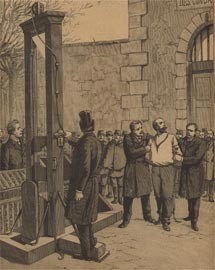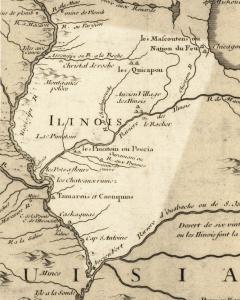Ladies and Gentlemen, meet the new Section 2267 of the Catechism of the Catholic Church:
“Recourse to the death penalty on the part of legitimate authority, following a fair trial, was long considered an appropriate response to the gravity of certain crimes and an acceptable, albeit extreme, means of safeguarding the common good.
 “Today, however, there is an increasing awareness that the dignity of the person is not lost even after the commission of very serious crimes. In addition, a new understanding has emerged of the significance of penal sanctions imposed by the state. Lastly, more effective systems of detention have been developed, which ensure the due protection of citizens but, at the same time, do not definitively deprive the guilty of the possibility of redemption.
“Today, however, there is an increasing awareness that the dignity of the person is not lost even after the commission of very serious crimes. In addition, a new understanding has emerged of the significance of penal sanctions imposed by the state. Lastly, more effective systems of detention have been developed, which ensure the due protection of citizens but, at the same time, do not definitively deprive the guilty of the possibility of redemption.
“Consequently, the Church teaches, in the light of the Gospel, that “the death penalty is inadmissible because it is an attack on the inviolability and dignity of the person”, and she works with determination for its abolition worldwide.” [1]
This replaces the previous Section 2267 of the Catechism, which read,
“Assuming that the guilty party’s identity and responsibility have been fully determined, the traditional teaching of the Church does not exclude recourse to the death penalty, if this is the only possible way of effectively defending human lives against the unjust aggressor.
“If, however, non-lethal means are sufficient to defend and protect people’s safety from the aggressor, authority will limit itself to such means, as these are more in keeping with the concrete conditions of the common good and more in conformity with the dignity of the human person.
 “Today, in fact, as a consequence of the possibilities which the state has for effectively preventing crime, by rendering one who has committed an offense incapable of doing harm—without definitively taking away from him the possibility of redeeming himself—the cases in which the execution of the offender is an absolute necessity ‘are very rare, if not practically non-existent.’” [2]
“Today, in fact, as a consequence of the possibilities which the state has for effectively preventing crime, by rendering one who has committed an offense incapable of doing harm—without definitively taking away from him the possibility of redeeming himself—the cases in which the execution of the offender is an absolute necessity ‘are very rare, if not practically non-existent.’” [2]
Naturally, there’s been an uproar. Most headlines are declaring that Pope Francis is changing Church teaching, and his enemies are saying the same thing. That wouldn’t be a problem except that Church teaching on faith and morals isn’t supposed to change. So what gives? Has the Pope actually changed Church teaching?
Without a doubt, the attitude of the Church toward the death penalty has changed over the years. The old Roman Catechism, published in 1566, said this:
“Another kind of lawful slaying belongs to the civil authorities, to whom is entrusted power of life and death, by the legal and judicious exercise of which they punish the guilty and protect the innocent. The just use of this power, far from involving the crime of murder, is an act of paramount obedience to this Commandment which prohibits murder. The end of the Commandment is the preservation and security of human life. Now the punishments inflicted by the civil authority, which is the legitimate avenger of crime, naturally tend to this end, since they give security to life by repressing outrage and violence. Hence these words of David: In the morning I put to death all the wicked of the land, that I might cut off all the workers of iniquity from the city of the Lord.” [3]
So what happened? The Catholic Church is supposed to be proclaiming timeless truths. How, then, can it be that capital punishment was permissible in 1566 but not in 2018?
The reason that the Roman Catechism gave for the death penalty was that it gives “security to life by repressing outrage and violence.” It provided a pro-life rationale for capital punishment! It thus superficially appears that the Church has completely reversed itself since the 16th century.
But here it isn’t trite to point out that things were different then. Nowadays, where capital punishment is opposed, a long imprisonment, even for life, is presented as the alternative. But that isn’t something that would have been likely to occur to anyone in 1566. In those days prisons “tended to be a place where people were held before their trial or while awaiting punishment. It was very rarely used as a punishment in its own right.” [4] Instead, sanctions “for criminal behaviour tended to be public events which were designed to shame the person and deter others; these included the ducking stool, the pillory, whipping, branding and the stocks. At the time the sentence for many other offences was death.” The first state prison for housing convicted offenders wasn’t constructed until the 19th century.
 When you don’t have prisons in the modern sense, it is pretty hard to confine dangerous people. But society has a right to defend itself, just as someone has a right to defend himself or his family. That’s why the previous version of Section 2267 of the Catechism said, “Assuming that the guilty party’s identity and responsibility have been fully determined, the traditional teaching of the Church does not exclude recourse to the death penalty, if this is the only possible way of effectively defending human lives against the unjust aggressor.” But it also said that if “non-lethal means are sufficient to defend and protect people’s safety from the aggressor, authority will limit itself to such means, as these are more in keeping with the concrete conditions of the common good and more in conformity with the dignity of the human person.” What’s more, it also observed that today, “as a consequence of the possibilities which the state has for effectively preventing crime, by rendering one who has committed an offense incapable of doing harm—without definitively taking away from him the possibility of redeeming himself—the cases in which the execution of the offender is an absolute necessity ‘are very rare, if not practically non-existent.’”
When you don’t have prisons in the modern sense, it is pretty hard to confine dangerous people. But society has a right to defend itself, just as someone has a right to defend himself or his family. That’s why the previous version of Section 2267 of the Catechism said, “Assuming that the guilty party’s identity and responsibility have been fully determined, the traditional teaching of the Church does not exclude recourse to the death penalty, if this is the only possible way of effectively defending human lives against the unjust aggressor.” But it also said that if “non-lethal means are sufficient to defend and protect people’s safety from the aggressor, authority will limit itself to such means, as these are more in keeping with the concrete conditions of the common good and more in conformity with the dignity of the human person.” What’s more, it also observed that today, “as a consequence of the possibilities which the state has for effectively preventing crime, by rendering one who has committed an offense incapable of doing harm—without definitively taking away from him the possibility of redeeming himself—the cases in which the execution of the offender is an absolute necessity ‘are very rare, if not practically non-existent.’”
As accurate a rendition of Catholic doctrine as the old version of Section 2267 was, some people found some wiggle room. The fact that it acknowledged that, theoretically, there can be circumstances where Catholic teaching wouldn’t prohibit the death penalty, made some decide that it was permissible to inflict capital punishment whenever the authorities thought it appropriate (using the “prudential judgment” language, of course).
So now we have a new Section 2267 that makes it abundantly plain that capital punishment has no place in the modern world, because we have the means of protecting society from violent offenders without killing them. And it has always been Catholic teaching that you shouldn’t kill anyone unless it is necessary to protect innocent lives. That’s the kernel. That’s the teaching that has been consistent all along.
We no longer have a need to kill anyone for even the most serious criminal offenses, because we have found a better way. Therefore, we shouldn’t do it. And that is all.
The icon of St. Joseph the Worker is by Daniel Nichols.
Listen to Christian Democracy on live internet radio on Tuesdays at 10:30 p.m. Eastern time at WCAT Radio here, or listen to the podcast here on the Christian Democracy Patheos blog.
Please go like Christian Democracy on Facebook here. Join the discussion on Catholic social teaching here.












